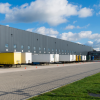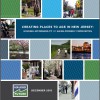Sprawl
The kind of suburban residential and commercial development that has been prevalent in New Jersey over the last 40 years is referred to as sprawl.
It is characterized by development of formerly “green” land; separated uses (homes, shopping, employment and recreational facilities far away from each other); low-density single-family homes on large lots; dependence on cars to get around; and little public open space.
Sprawl development has turned out to be harmful to the state and its residents. Automobile-related pollution, loss of farmland, increased rates of obesity and increasingly unsustainable property tax rates are just some of the effects of sprawl development.
Smart-growth development, by contrast, seeks to direct growth to areas where infrastructure already exists, where higher densities make the provision of public services less expensive on a per-capita basis, and where different kinds of uses can be located near each other for easy access by residents without needing to drive, where the same amount of land produces higher tax revenues, and where transportation options other than cars are readily available.

The State Planning Commission at its Sept. 7 meeting officially adopted the Warehouse Siting Guidance drafted by the Office of Planning Advocacy (OPA) earlier this summer, intended for use by municipalities in deciding how best to plan for warehouse developments.

Industries devoted to the movement and storage of goods are a pillar of New Jersey’s economy, providing jobs to nearly one out of every eight employed New Jersey residents. Growth in e-commerce and in the volume of international trade arriving at the country’s second-busiest port, the major facilities of which are located in North Jersey, are creating unprecedented demand for warehouse space.

The Office of Planning Advocacy, the staff for the State Planning Commission, has issued first-of-its-kind guidance on where and how warehouses should be located in New Jersey.

Earlier this year, New Jersey Future released a report about the growth of warehousing in New Jersey, and that growth pressure has only grown more intense in the intervening months. The report focused mainly on the use—and in many cases, the re-use—of land for warehouse development and its impact on host communities in terms of […]

The warehouse development that has been steadily spreading south into farm fields along the New Jersey Turnpike might be a preview of things to come if we fail to plan for the growth in the movement and storage of stuff.

This report identifies strategies to lower both cost and risk in redevelopment projects, as redevelopment increasingly becomes the norm for accommodating growth in New Jersey. January 2016.

In this report, New Jersey Future analyzed housing affordability in each New Jersey municipality, to see where households headed by someone 65 or older have high housing costs. The places where housing cost burden is greatest fall into two groups: towns that are expensive for everyone, and towns that are dominated by larger, single-family housing stock. December 2015.

In this report, New Jersey Future and Smart Growth America analyzed per-capita road usage. The results show that places with the highest activity density have the lowest per-capita usage, suggesting per-capita road-maintenance costs can be reduced by even marginal increases in density. November 2015.

The Economic Opportunity Act of 2013 included additional incentives for projects destined for “smart-growth” areas. This report analyzes how effective the updated incentives have been at directing growth to those areas. December 2014.

There is a significant mismatch in New Jersey between where large numbers of older residents live and which municipalities are most prepared to accommodate them. This report matches every municipality against four age-friendliness indicators, and analyzes the degree to which New Jersey’s older residents are living in places that, from a land-use perspective, are not prepared to accommodate their changing needs. January 2014.
See all New Jersey Future Blog posts and articles in this category »
Reports, Presentations and Testimony
- 02/11/2019: Testimony on Economic Development Incentives
- New Jersey Future 2017 Gubernatorial Platform
- New Jersey Future Redeveloping the Norm 01-16 (Intern Report)
- fiscal-implications-roads-in-new-jersey
- Economic-Opportunity-Act-and-Smart-Growth-Progress-Report
- PINELANDS_WEB_8_4_14-1
- New Jersey Future Van Abs 2014 Pinelands Growth Area Water Assessment
- Creating Great Places To Age in New Jersey
- Creating Places To Age in New Jersey Municipal Best Practices
- Creating Places To Age in New Jersey municipal data
- Creating Places To Age Bergen-Passaic Supplement
- How Clustering Works
- Clustering-Factsheet_11_5_2013
- Cluster-Development-Act-summary-of-key-provisions-10-13
- Land Use Trends NJPHA 2011
- Financial Benefits of Density in Two New Jersey Downtowns 7-11 (Intern report)
- Smart Growth NJ August 2011 Poll Report
- Route 1 Planning Through Partnerships
- Case Studies in Transfer of Development Rights 8-10 (Intern report)
- Transfer of Development Rights Task Force Report 08-11-10
- APA-NJ Non-Contiguous Clustering 3-08
- Case Study Hopewell Township 08-00
- Achieving Genuine Prosperity 04-01
- Rethinking Farmland Preservation in New Jersey 05-01
- Presentation: The Status of Transfer of Development Rights in New Jersey 12-10
- Transfer of Development Rights (Updated) 05-04
- Smart Conservation: The "Green" Side of Smart Growth
- Race to the Middle: The Homogenization of New Jersey's Population Density
- Moving Out: New Jersey's Population Growth and Migration Patterns
- Getting to Work 11-08
- Built Out Permit Activity 12-10
- Built Out 12-10











